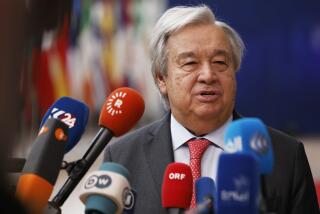North Korean propaganda shows imagery of the South’s leader being blown up
- Share via
reporting from SEOUL — As text crawls across the screen telling viewers about the “last breath of the hideous American monsters,” an image of the White House explodes in a profusion of low-tech graphics that seem straight from a 1980s video game.
The three-minute video, posted on a propaganda website last week, also depicts a destructive attack on South Korea’s presidential office and appears to show the country’s president, Park Geun-hye, being blown up.
Pyongyang kept up the onslaught with a statement pledging “a retaliatory war to eliminate the United States and President Park’s followers in the name of justice,” along with reported Scud missile launches, threats to annihilate New York City and claims to have miniaturized nuclear warheads, a dubious declaration but one that, if true, would make it technically possible for North Korea to carry out a nuclear strike on the mainland U.S.
Menacing words and images from North Korea’s state propaganda machine are nothing new, but observers of the reclusive state say they’ve noticed a recent uptick in the frequency and provocative nature of the threats. The volley of threats also comes ahead of Park’s scheduled meeting this week with President Obama to discuss, among other things, North Korea.
The testiness comes in apparent response to the United Nations and U.S. enacting sanctions aimed at cutting North Korea off from the global economy and squeezing off the foreign currency that funds its weapons programs.
Also, the U.S. and South Korea are currently carrying out military training exercises in South Korea. Every spring North Korea voices objections to the exercises, which it calls dress rehearsals for invading its territory. The U.S and South Korea describe them as practice runs for the possibility of a North Korean attack.
The drills started in early March and will run until late April, with about 17,000 U.S. troops participating in cooperation with 300,000 of their South Korean counterparts. The exercises are held every year, though they are larger this year.
In recent months the South Korean government has appeared to lose patience with Pyongyang and has adopted a firmer posture, taking measures such as shutting down a jointly operated industrial complex, which had been the final remaining economic cooperation project between the two countries. Last month Park had unusually harsh words for the North when she said Pyongyang’s stubborn pursuit of nuclear weapons would only lead to the government’s collapse.
North Korea often mocks Park, calling her a “hateful witch” and “prostitute,” among other insults. Still, Tuesday’s video represented an escalation of the vitriol and marked the first time it released imagery appearing to show Park’s death.
The tough talk is for the most part a show for the people at home, designed to create an image of strength and autonomy, analysts suggest.
“The brinkmanship rhetoric should play very well, creating the impression that the regime is standing up against the U.S.,” said Timothy S. Rich, an assistant professor at Western Kentucky University who has written on North Korean propaganda.
North Korea also has an eye on the U.S., and it is no accident that Pyongyang is making noise during a U.S. presidential election cycle, said Michael Madden, a contributing analyst to 38 North, a North Korean affairs website run by the Paul H. Nitze School of Advanced International Studies at Johns Hopkins University.
Madden called the latest round of threats “a preview of coming attractions for the next American president.”
Under Obama’s watch, Washington has negotiated landmark deals toward cooperation with previously unfriendly governments, such as Cuba and Iran. But no such progress has been made with North Korea.
In 2009, early in Obama’s first term, North Korea carried out a multistage rocket launch and nuclear test, which pushed Washington to condemn Pyongyang’s flouting of international norms on nuclear nonproliferation and made it nearly impossible to work toward bilateral peace talks.
The two sides held direct talks in 2011 and 2012, culminating in an agreement under which North Korea pledged to refrain from nuclear and long-range missile tests. But the agreement dissolved a few weeks later when North Korea violated its terms by using ballistic missile technology to launch a satellite.
The Obama administration refers to its North Korea policy as “strategic patience,” code for waiting for North Korea to take credible steps toward denuclearization.
But North Korea appears to have a different strategy.
“North Korea is done trying to work with the Obama administration,” Madden said. “They want to make it clear to whoever the next president is that part of the job is dealing with North Korea.”
Borowiec is a special correspondent.
More to Read
Sign up for Essential California
The most important California stories and recommendations in your inbox every morning.
You may occasionally receive promotional content from the Los Angeles Times.













